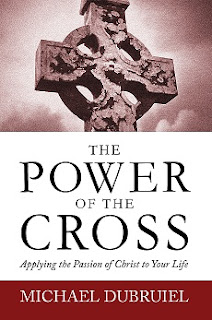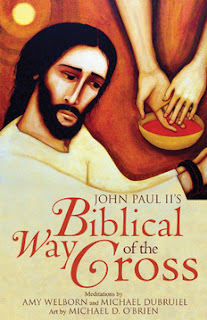The Cross of Christ Unites. . . the Temporal and Eternal
For we did not follow cleverly devised myths when we made known to you the power and coming of our Lord Jesus Christ, but we were eyewitnesses of his majesty. For when he received honor and glory from God the Father and the voice was borne to him by the Majestic Glory, “This is my beloved Son, with whom I am well pleased,” we heard this voice borne from heaven, for we were with him on the holy mountain. And we have the prophetic word made more sure. You will do well to pay attention to this as to a lamp shining in a dark place, until the day dawns and the morning star rises in your hearts. 2 PETER 1:16–19
And Peter said to Jesus, “Lord, it is well that we are here; if you wish, I will make three booths here, one for you and one for Moses and one for Elijah.” He was still speaking, when lo, a bright cloud overshadowed them, and a voice from the cloud said, “This is my beloved Son, with whom I am well pleased; listen to him.” When the disciples heard this, they fell on their faces, and were filled with awe. But Jesus came and touched them, saying, “Rise, and have no fear.” MATTHEW 17:4–7 Last year my wife and I were in downtown Cleveland when the power suddenly and inexplicably went out all over the city. It was a Thursday afternoon, at the height of rush hour; as we listened to the radio, we discovered that the blackout had affected much of the northeast, including Boston, Ontario, New York, and Detroit.
That night, the eve of the Feast of the Assumption, we had planned to attend the Divine Liturgy for the Feast of the Dormition of Mary at a Byzantine Catholic Church in the city. As we gathered at the church with a few other hardy souls, the darkness heightened our awareness of the smoking incense, gleaming candlelight, and jangling bells. Attentively we listened to the reading from the Book of Revelation, “A great portent appeared in the heavens.” Back outside, darkness.
The highway was a ribbon of light, streaming both ways, but once we got off the interstate and made our way to the hotel, all was dark again, save a few candles that the hotel staff had placed on some tables. Everyone at the hotel that night was outside. There was a nervous air to the conversation; everyone wondered when the lights would come back on—and why we were sitting in the darkness in the first place. Finally the hotel staff closed the pool area, and everyone went back to their stuffy hotel rooms. There was no air conditioning, and when I opened a window the air outside did not offer any real relief. Standing by the window, I peered into the night sky and searched the horizon futilely for signs of light. The bustling city of Cleveland was silent and still, and the darkness continued through the night and into the early morning, a few hours before the natural light of the sun would rise once again.
That experience of darkness brought to mind other images of light and darkness— particularly the Light of God versus the darkness of the world. Peter in his second letter pointed to the Transfiguration of Our Lord as a defining moment, “a light shining in a dark place.” Typically, it is only when the lights go out in our lives that we realize how much we need them.
Mel Gibson’s movie The Passion of the Christ depicted Jesus’ Passion and death with overwhelming violence. As gripping as the imagery was, however, it brought to mind scenes I had witnessed on the nightly news that same week. A Jerusalem bus blown up by a terrorist, leaving the streets covered with blood and body parts. An explosion in Iraq that had left bloody bodies everywhere. Three-year-old Lebanese boys slashed with a sword, their foreheads a bloody mess, as their parents proclaimed a willingness to give up these children to die for their cause. All the violence in our world shrouds it in darkness.
At the Transfiguration, Jesus took Peter, James, and John with him to the top of Mount Tabor to pray. While they were praying, Our Lord’s appearance changed, becoming luminous, and the Scriptures tell us: “And behold, two men talked with him, Moses and Elijah, who appeared in glory and spoke of his departure, which he was to accomplish at Jerusalem.”(Luke 9:30–31) Luke’s Gospel alone tells us what Jesus talked about with Moses and Elijah: his impending journey to Jerusalem, and his “departure”—that is, his crucifixion—that would be accomplished in that place.
Good Friday brought about the first true power outage in recorded history. Long before there was electrical power, we are told, “from the sixth hour there was darkness over all the land until the ninth hour” (Matthew 27:45). This darkness wasn’t caused by an incoming thunderstorm; men caused the darkness when they tried to extinguish the Light of the World!
Yet at the moment of his Transfiguration, as he anticipated in prayer the Good Friday that was to come, Our Lord’s face was made as bright as the sun. St. Peter’s response to this miracle was, “Lord, it is well that we are here!” As they journeyed with Jesus in prayer, every moment of the disciples’ lives was an epiphany, an encounter with the Divine. May we, like them, experience that the “light has shone in the darkness.”
Prayer That Transforms Life
If we want to learn anything about the Paschal mystery of Jesus’ Passion, death, and resurrection here on the mountain of the Transfiguration, we must approach these mysteries on our knees. It all begins with prayer. Jesus climbed the mountain to be alone with the three disciples, to pray with them. Every effort of prayer begins with an invitation to “come aside.” Just as Our Lord called Peter, James, and John to come with him up the mountain, he beckons to us today. When we feel that inner nudge, that desire to pray, we must pay attention to God’s call. It may be difficult to respond to the invitation at times. We need not climb a mountain, at least not literally. However, we do need a place to “come aside.” It may be a special corner of our room, or a nearby chapel; no matter where it is, the trip to put oneself into God’s presence may seem like scaling the side of a precipice at times. This is to be expected: We are entering a different realm. As Peter, James, and John discovered, in leading them up the mountain Jesus had taken them higher than the geological summit; he had transported them to heaven itself. They were able to witness Moses and Elijah, conversing with Jesus in prayer and blinding light!
As we contemplate the face of Jesus in this “mystery of light,” God’s purpose for us is revealed. We receive light to illumine our darkness, and strength to persevere as we face our own Good Fridays, when it seems all has been lost. But as we pray before the cross, the Master opens our eyes, enabling us to see the light. Jesus himself comes to us and says, “Rise and have no fear!” When we receive this foretaste of the kingdom, where “the righteous will shine like the sun” (Matthew 13:43), may we say with St. Peter: “Lord, it is good that we are here!”
The Power of the Cross by Michael Dubruiel is a book well-suited to daily reading during Lent. The book is available
here in pdf version. Daily excerpts will be reprinted in this space during Lent.


